9 Primary Sources: Neolithic Art and Architecture
Dr. Beth Harris; Dr. Steven Zucker; Dr. Bryan Zygmont; Dr. Senta German; and Mary Beth Looney
The Neolithic Revolution
A settled life
When people think of the Neolithic era, they often think of Stonehenge, the iconic image of this early time. Dating to approximately 3000 B.C.E. and set on Salisbury Plain in England, it is a structure larger and more complex than anything built before it in Europe. Stonehenge is an example of the cultural advances brought about by the Neolithic revolution—the most important development in human history. The way we live today, settled in homes, close to other people in towns and cities, protected by laws, eating food grown on farms, and with leisure time to learn, explore and invent is all a result of the Neolithic revolution, which occurred approximately 11,500-5,000 years ago. The revolution which led to our way of life was the development of the technology needed to plant and harvest crops and to domesticate animals.
Before the Neolithic revolution, it’s likely you would have lived with your extended family as a nomad, never staying anywhere for more than a few months, always living in temporary shelters, always searching for food and never owning anything you couldn’t easily pack in a pocket or a sack. The change to the Neolithic way of life was huge and led to many of the pleasures (lots of food, friends and a comfortable home) that we still enjoy today.
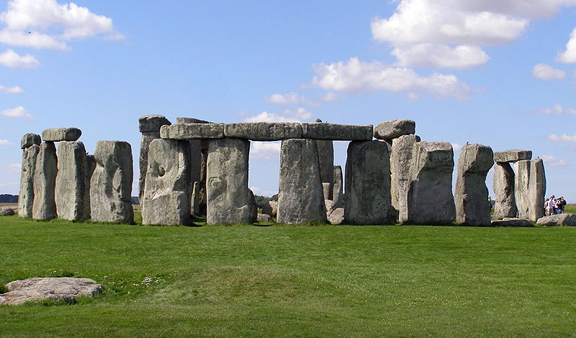
Editor’s Note: Each of the trilithons that form Stonehenge is comprised of three megaliths: two uprights and one balanced across the top. Post-and-lintel is a construction technique used in the Neolithic period and well beyond. It was used for both above-ground structures and underground burial chambers. Another building technique developed in the Neolithic period is the corbeled dome, as can be seen at the passage tomb at Newgrange.

Neolithic art
The massive changes in the way people lived also changed the types of art they made. Neolithic sculpture became bigger, in part, because people didn’t have to carry it around anymore; pottery became more widespread and was used to store food harvested from farms. Alcohol was first produced during this period and architecture, as well as its interior and exterior decoration, first appears. In short, people settled down and began to live in one place, year after year.
It seems very unlikely that Stonehenge could have been made by earlier, Paleolithic, nomads. It would have been a waste to invest so much time and energy building a monument in a place to which they might never return or might only return infrequently. After all, the effort to build it was extraordinary. Stonehenge is approximately 320 feet in circumference and the stones which compose the outer ring weigh as much as 50 tons; the small stones, weighing as much as 6 tons, were quarried from as far away as 450 miles. The use or meaning of Stonehenge is not clear, but the design, planning and execution could have only been carried out by a culture in which authority was unquestioned. Here is a culture that was able to rally hundreds of people to perform very hard work for extended periods of time. This is another characteristic of the Neolithic era.
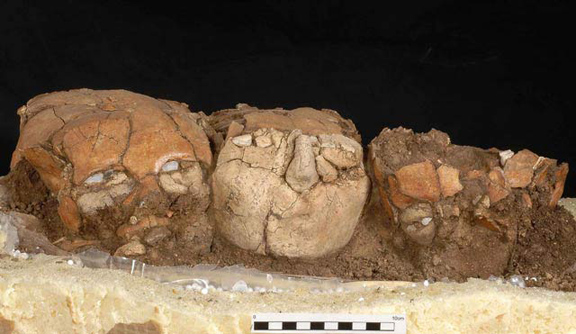
Plastered skulls
The Neolithic period is also important because it is when we first find good evidence for religious practice, a perpetual inspiration for the fine arts. Perhaps most fascinating are the plaster skulls found around the area of the Levant, at six sites, including Jericho. At this time in the Neolithic, c. 7000-6,000 B.C.E., people were often buried under the floors of homes, and in some cases their skulls were removed and covered with plaster in order to create very life-like faces, complete with shells inset for eyes and paint to imitate hair and mustaches.
The traditional interpretation of these the skulls has been that they offered a means of preserving and worshiping male ancestors. However, recent research has shown that among the sixty-one plastered skulls that have been found, there is a generous number that come from the bodies of women and children. Perhaps the skulls are not so much religious objects but rather powerful images made to aid in mourning lost loved ones.
Neolithic peoples didn’t have written language, so we may never know what their creators intended. (The earliest example of writing develops in Sumer in Mesopotamia in the late 4th millennium B.C.E. However, there are scholars that believe that earlier proto-writing developed during the Neolithic period).
Jericho
A natural oasis
The site of Jericho, just north of the Dead Sea and due west of the Jordan River, is one of the oldest continuously lived-in cities in the world. The reason for this may be found in its Arabic name, Ārīḥā, which means fragrant; Jericho is a natural oasis in the desert where countless fresh water springs can be found. This resource, which drew its first visitors between 10,000 and 9000 B.C.E., still has descendants that live there today.

Biblical reference
The site of Jericho is best known for its identity in the Bible and this has drawn pilgrims and explorers to it as early as the 4th century C.E.; serious archaeological exploration didn’t begin until the latter half of the 19th century. What continues to draw archaeologists to Jericho today is the hope of finding some evidence of the warrior Joshua, who led the Israelites to an unlikely victory against the Canaanites (“the walls of the city fell when Joshua and his men marched around them blowing horns” Joshua 6:1-27). Although unequivocal evidence of Joshua himself has yet to be found, what has been uncovered are some 12,000 years of human activity.
The most spectacular finds at Jericho, however, do not date to the time of Joshua, roughly the Bronze Age (3300-1200 B.C.E.), but rather to the earliest part of the Neolithic era, before even the technology to make pottery had been discovered.
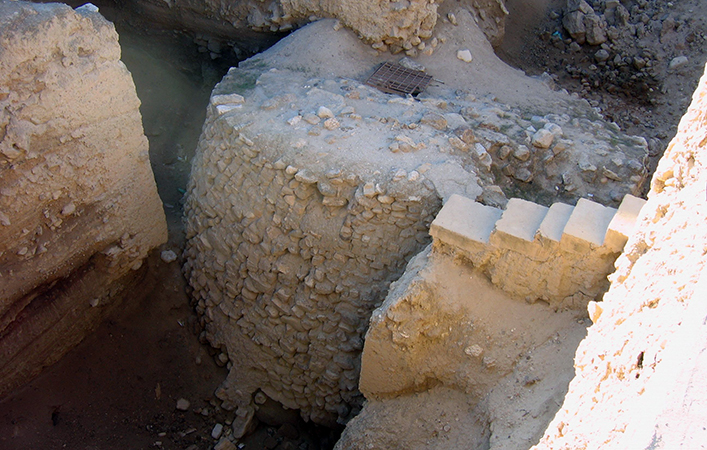
Old walls
The site of Jericho rises above the wide plain of the Jordan Valley, its height the result of layer upon layer of human habitation, a formation called a Tell. The earliest visitors to the site who left remains (stone tools) came in the Mesolithic period (around 9000 B.C.E.) but the first settlement at the site, around the Ein as-Sultan spring, dates to the early Neolithic era, and these people, who built homes, grew plants, and kept animals, were among the earliest to do such anywhere in the world. Specifically, in the Pre-Pottery Neolithic A levels at Jericho (8500-7000 B.C.E.) archaeologists found remains of a very large settlement of circular homes made with mud brick and topped with domed roofs.
As the name of this era implies, these early people at Jericho had not yet figured out how to make pottery, but they made vessels out of stone, wove cloth and for tools were trading for a particularly useful kind of stone, obsidian, from as far away as Çiftlik, in eastern Turkey. The settlement grew quickly and, for reasons unknown, the inhabitants soon constructed a substantial stone wall and exterior ditch around their town, complete with a stone tower almost eight meters high, set against the inner side of the wall. Theories as to the function of this wall range from military defense to keeping out animal predators to even combating the natural rising of the level of the ground surrounding the settlement. However, regardless of its original use, here we have the first version of the walls Joshua so ably conquered some six thousand years later.
Plastered human skulls
The Pre-Pottery Neolithic A period is followed by the Pre-Pottery Neolithic B (7000-5200 BCE), which was different from its predecessor in important ways. Houses in this era were uniformly rectangular and constructed with a new kind of rectangular mud bricks which were decorated with herringbone thumb impressions, and always laid lengthwise in thick mud mortar. This mortar, like a plaster, was also used to create a smooth surface on the interior walls, extending down across the floors as well. In this period there is some strong evidence for cult or religious belief at Jericho. Archaeologists discovered one uniquely large building dating to the period with unique series of plastered interior pits and basins as well as domed adjoining structures and it is thought this was for ceremonial use.
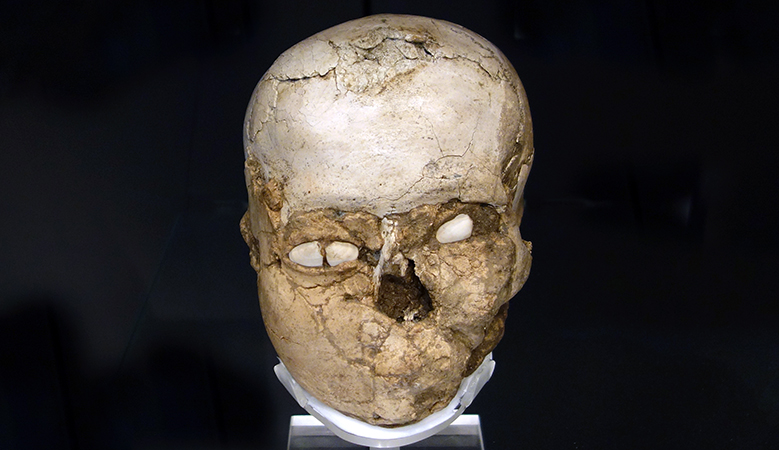
Other possible evidence of cult practice was discovered in several homes of the Pre-Pottery Neolithic town, in the form of plastered human skulls which were molded over to resemble living heads. Shells were used for eyes and traces of paint revealed that skin and hair were also included in the representations. The largest group found together were nine examples, buried in the fill below the plastered floor of one house.
Jericho isn’t the only site at which plastered skulls have been found in Pre-Pottery Neolithic B levels; they have also been found at Tell Ramad, Beisamoun, Kfar Hahoresh, ‘Ain Ghazal and Nahal Hemar. Among the some sixty-two skulls discovered among these sites, we know that older and younger men as well as women and children are represented, which poses interesting questions as to their meaning. Were they focal points in ancestor worship, as was originally thought, or did they function as images by which deceased family members could be remembered? As we are without any written record of the belief system practiced in the Neolithic period in the area, we will never know.
Online Resources: The Jericho Skull
The British Museum, “The oldest portrait in the British Museum (probably) | Curator’s Corner S2 Ep 1” (https://youtu.be/bMZWsM687MY)
Also check out The Jericho Skull by The British Museum on Sketchfab
Phases of Neolithic Art
By Lumen Learning, Boundless Art History
Art in the Neolithic Near East owes its existence to developments in agriculture, architecture, and other areas…. Neolithic culture in the Near East is separated into three phases: Neolithic 1 (Pre-Pottery Neolithic A), Neolithic 2 (Pre-Pottery Neolithic B), and Neolithic 3 (Pottery Neolithic).
Neolithic 1 (PPNA)

The Neolithic 1 phase likely began with a temple in southeastern Turkey at Gobekli Tepe circa 10,000 BCE. The structure is as the oldest known human-made place of worship. It features seven stone circles covering 25 acres that contain limestone pillars carved with animals, insects, and birds, believed to serve as roof supports. The complexity of the temple and the effort involved in its construction imply it was built by long-term settlers. The major advances of the Neolithic 1 phase revolve around developments in farming practices, such as harvesting, seed selection, and the domestication of plants and animals.
At the oldest layer of Gobekli Tepe, T-shaped mud brick pillars are decorated with abstract , enigmatic pictograms and carved animal reliefs. The pictograms may represent commonly understood sacred symbols known from Neolithic cave paintings elsewhere. The reliefs depict mammals such as lions, bulls, boars, foxes, gazelles, and donkeys; snakes and other reptiles; arthropods, such as insects and arachnids; and birds, particularly vultures. The deceased were likely exposed for consumption by vultures and other carrion birds.
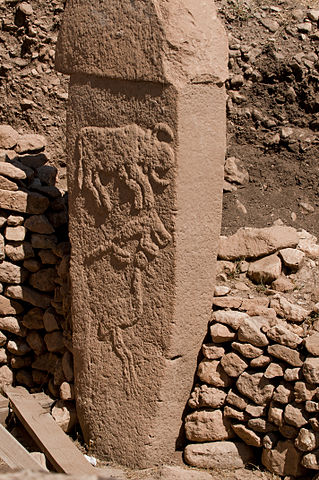
When the edifice was constructed, the surrounding country was likely forested and capable of sustaining this variety of wildlife, before millennia of settlement and cultivation led to the near-Dust Bowl conditions prevalent today.
Neolithic 2 (PPNB)
The Neolithic 2 began around 8800 BCE and is characterized by settlements built with rectangular mud-brick houses with single or multiple rooms, the greater use of domesticated animals, and advancements in tools. These developments in architecture point to settlement in permanent locations. While mud brick is perishable, the investment of time and effort in the construction of houses indicates the desire to remain in a single location for the long term. Burial findings and the preservation of skulls of the dead, often plastered with mud to create facial features, suggest an ancestor cult.
A settlement of 3,000 inhabitants was found in the outskirts of Amman, Jordan. Considered to be one of the largest prehistoric settlements in the Near East, ‘Ain Ghazal was continuously inhabited from approximately 7,250 – 5,000 BCE. This settlement produced what are believed to be the earliest large-scale human figures. Modeled from plaster, these consist of full statues and busts, some of which are two-headed. Great effort was put into modeling the heads, with wide-open eyes and bitumen-outlined irises. The statues represent men, women, and children. Women are recognizable by features resembling breasts and slightly enlarged bellies, but neither male nor female sexual characteristics are emphasized, and none of the statues have genitals. Only the faces have detail.
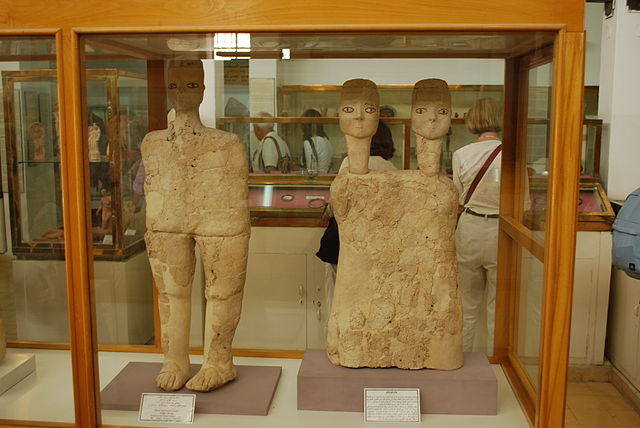
Although they were produced to be free-standing, they were likely intended to be viewed only from the front, hence their disproportionate flatness. The manufacture of the statues would not have permitted them to last long. Since they were buried in pristine condition, they may have been produced for the purpose of intentional burial and never been displayed.
Neolithic 3 (PN)
Beginning around 6400 BCE, this period is characterized by the emergence of distinctive cultures throughout the Fertile Crescent , such as the Halafian (Turkey, Syria, Northern Mesopotamia) and Ubaid (Southern Mesopotamia).
Pottery was first produced and used in this era, a direct effect of agriculture and the permanent settlements that arose as a result. No longer nomadic , individuals used ceramic vessels to store the food they grew or raised and water collected from local sources. Additionally, the need arose for plates, cups, and additional objects used in the consumption of food and beverages.
Halafian Period
Tell Halaf is an archaeological site in northeastern Syria near the Turkish border, that flourished from about 6100 to 5400 BCE. It was the first site of Neolithic culture, subsequently dubbed Halafian culture, characterized by glazed pottery painted with geometric and animal designs.
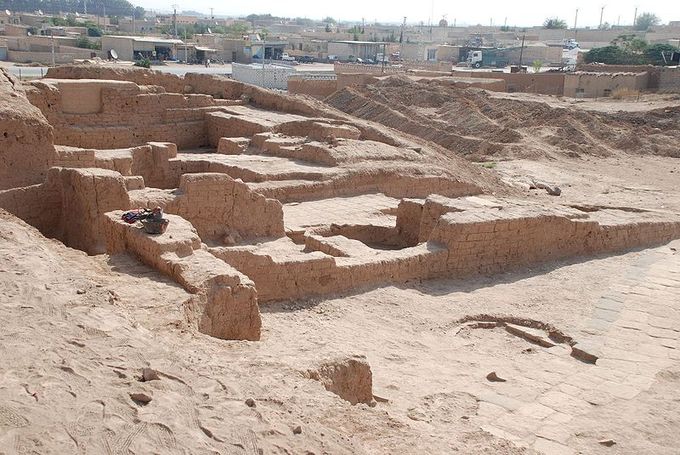
The best known, most characteristic pottery of Tell Halaf, called Halaf ware, was produced by specialist potters. It was sometimes painted with one or two colors (the latter called polychrome with geometric and animal motifs . Other types of Halaf pottery include unpainted cookware and ware with burnished surfaces.

There are many theories about the development of this distinctive pottery style . The polychromatic painted Halaf pottery has been proposed to be a “trade pottery”—pottery produced for export—however, the predominance of locally produced painted pottery in all areas of Halaf sites calls that theory into question. That said, Halaf pottery has been found in other parts of northern Mesopotamia and at many sites in Anatolia (Turkey) suggesting that it was widely used in the region.
Halafian pottery
These pieces were produced by specialist potters. Some were painted with geometric and animal motifs.
In addition to ceramics, the Halafian culture produced female figurines of partially baked clay and stone. Because of the prominence of their breasts and abdomens and subordination of their facial features, they are likely fertility figures. As the bands on the figure below suggest, these figurines were painted to some extent.
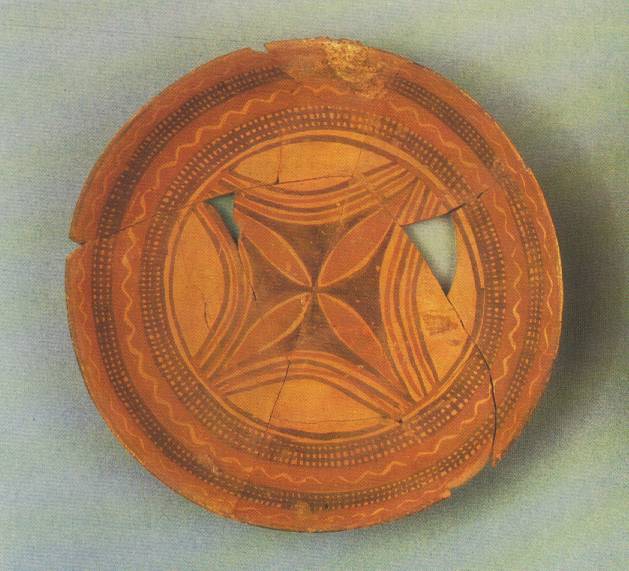
Ubaid Period
The Ubaid culture flourished from about 6500 to 3800 BCE in Mesopotamia and is characterized by large village settlements that employed multi-room rectangular mud-brick houses. The appearance of the first temples in Mesopotamia, as well as greenish pottery decorated with geometric designs in brown or black paint, are important developments of this period. Tell-al-Ubaid is a low, relatively small mound site that extends about two meters above ground level. The lower level was a site where large amounts of Ubaid pottery, kilns, and a cemetery were discovered.
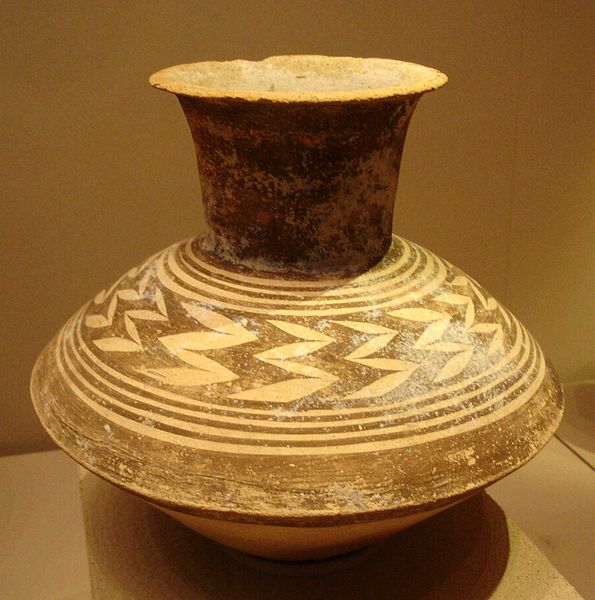
Çatalhöyük
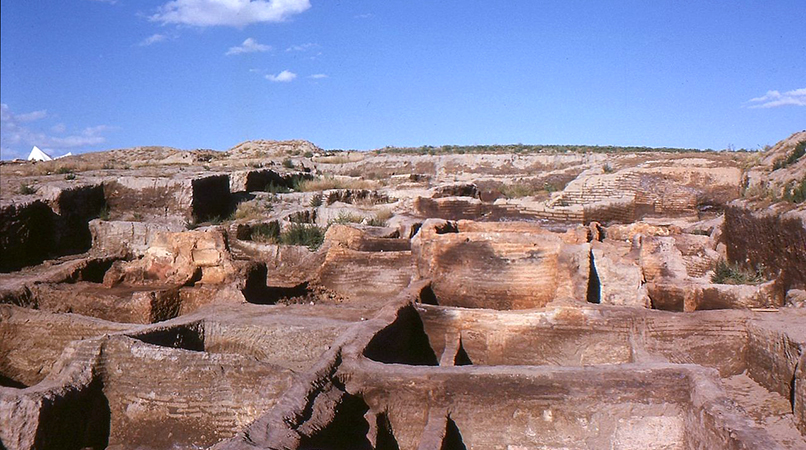
Çatalhöyük or Çatal Höyük (pronounced “cha-tal hay OOK”) is not the oldest site of the Neolithic era or the largest, but it is extremely important to the beginning of art. Located near the modern city of Konya in south central Turkey, it was inhabited 9000 years ago by up to 8000 people who lived together in a large town. Çatalhöyük, across its history, witnesses the transition from exclusively hunting and gathering subsistence to increasing skill in plant and animal domestication. We might see Çatalhöyük as a site whose history is about one of man’s most important transformations: from nomad to settler. It is also a site at which we see art, both painting and sculpture, appear to play a newly important role in the lives of settled people.

Çatalhöyük had no streets or foot paths; the houses were built right up against each other and the people who lived in them traveled over the town’s rooftops and entered their homes through holes in the roofs, climbing down a ladder. Communal ovens were built above the homes of Çatalhöyük and we can assume group activities were performed in this elevated space as well.
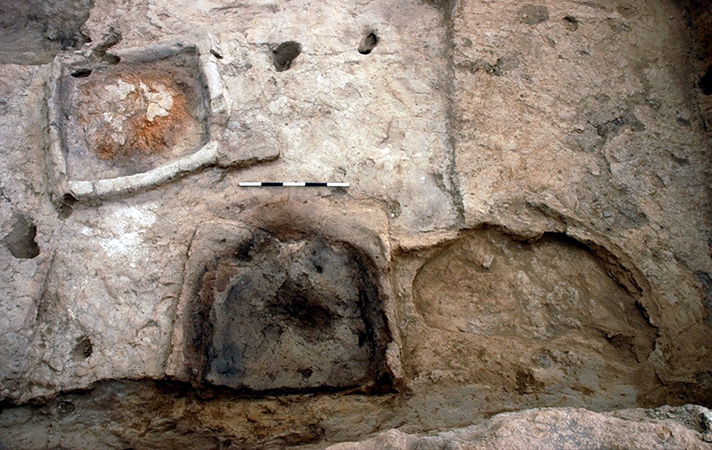
Like at Jericho, the deceased were placed under the floors or platforms in houses and sometimes the skulls were removed and plastered to resemble live faces. The burials at Çatalhöyük show no significant variations, either based on wealth or gender; the only bodies which were treated differently, decorated with beads and covered with ochre, were those of children. The excavator of
Çatalhöyük believes that this special concern for youths at the site may be a reflection of the society becoming more sedentary and required larger numbers of children because of increased labor, exchange and inheritance needs.
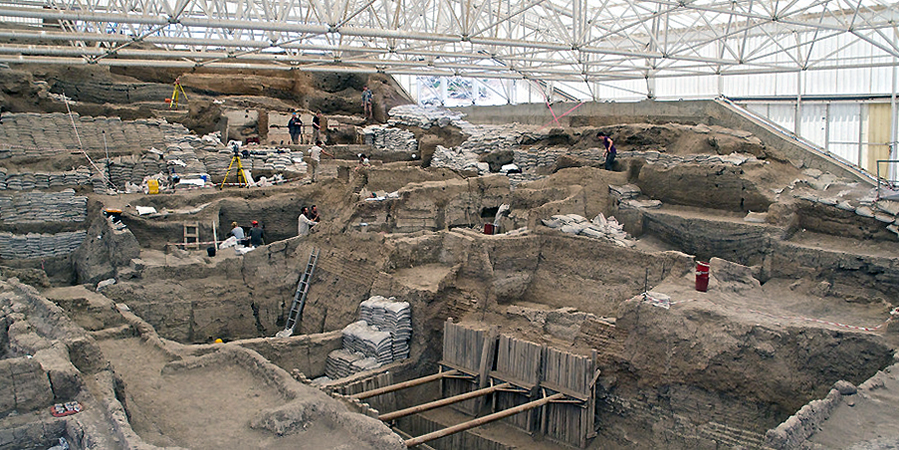
Art is everywhere among the remains of Çatalhöyük, geometric designs as well as representations of animals and people. Repeated lozenges and zigzags dance across smooth plaster walls, people are sculpted in clay, pairs of leopards are formed in relief facing one another at the sides of rooms, hunting parties are painted baiting a wild bull. The volume and variety of art at Çatalhöyük is immense and must be understood as a vital, functional part of the everyday lives of its ancient inhabitants.
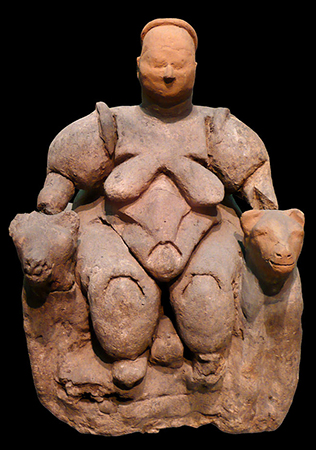
Many figurines have been found at the site, the most famous of which illustrates a large woman seated on or between two large felines. The figurines, which illustrate both humans and animals, are made from a variety of materials but the largest proportion are quite small and made of barely fired clay. These casual figurines are found most frequently in garbage pits, but also in oven walls, house walls, floors and left in abandoned structures. The figurines often show evidence of having been poked, scratched or broken, and it is generally believed that they functioned as wish tokens or to ward off bad spirits.
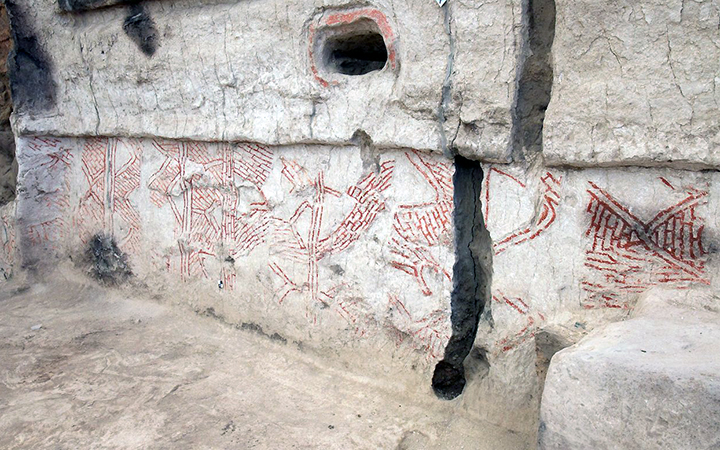
Nearly every house excavated at Çatalhöyük was found to contain decorations on its walls and platforms, most often in the main room of the house. Moreover, this work was constantly being renewed; the plaster of the main room of a house seems to have been redone as frequently as every month or season. Both geometric and figural images were popular in two-dimensional wall
painting and the excavator of the site believes that geometric wall painting was particularly associated with adjacent buried youths. Figural paintings show the animal world alone, such as, for instance, two cranes facing each other standing behind a fox, or in interaction with people, such as a vulture pecking at a human corpse or hunting scenes. Wall reliefs are found at Çatalhöyük with some frequency, most often representing animals, such as pairs of animals facing each other and human-like creatures. These latter reliefs, alternatively thought to be bears, goddesses or regular humans, are always represented splayed, with their heads, hands and feet removed, presumably at the time the house was abandoned.
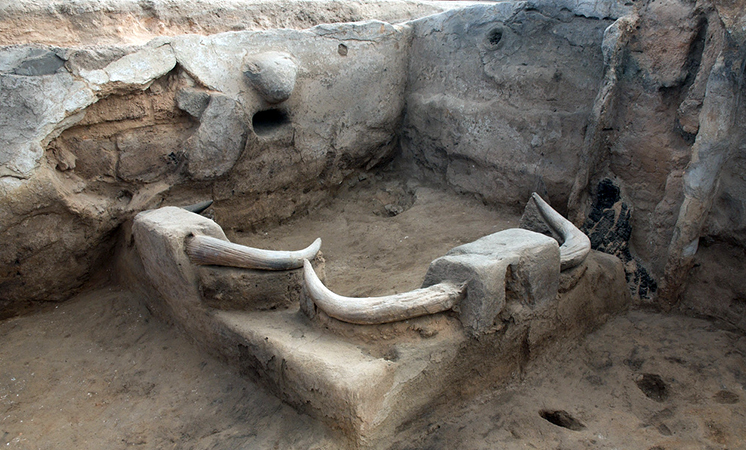
The most remarkable art found at Çatalhöyük, however, are the installations of animal remains and among these the most striking are the bull bucrania. In many houses the main room was decorated with several plastered skulls of bulls set into the walls (most common on East or West walls) or platforms, the pointed horns thrust out into the communal space. Often the bucrania would be painted ochre red. In addition to these, the remains of other animals’ skulls, teeth, beaks, tusks or horns were set into the walls and platforms, plastered and painted. It would appear that the ancient residents of Çatalhöyük were only interested in taking the pointy parts of the animals back to their homes!
How can we possibly understand this practice of interior decoration with the remains of animals? A clue might be in the types of creatures found and represented. Most of the animals represented in the art of Çatalhöyük were not domesticated; wild animals dominate the art at the site. Interestingly, examination of bone refuse shows that the majority of the meat which was consumed was of wild animals, especially bulls. The excavator believes this selection in art and cuisine had to do with the contemporary era of increased domestication of animals and what is being celebrated are the animals which are part of the memory of the recent cultural past, when hunting was much more important for survival.
Articles in this chapter:
- Dr. Senta German, “The Neolithic revolution,” in Smarthistory, June 8, 2018
- Dr. Senta German, “Jericho,” in Smarthistory, August 8, 2015
- Lumen Learning, “The Neolithic Period“
- Dr. Senta German, “Çatalhöyük,” in Smarthistory, August 8, 2015

